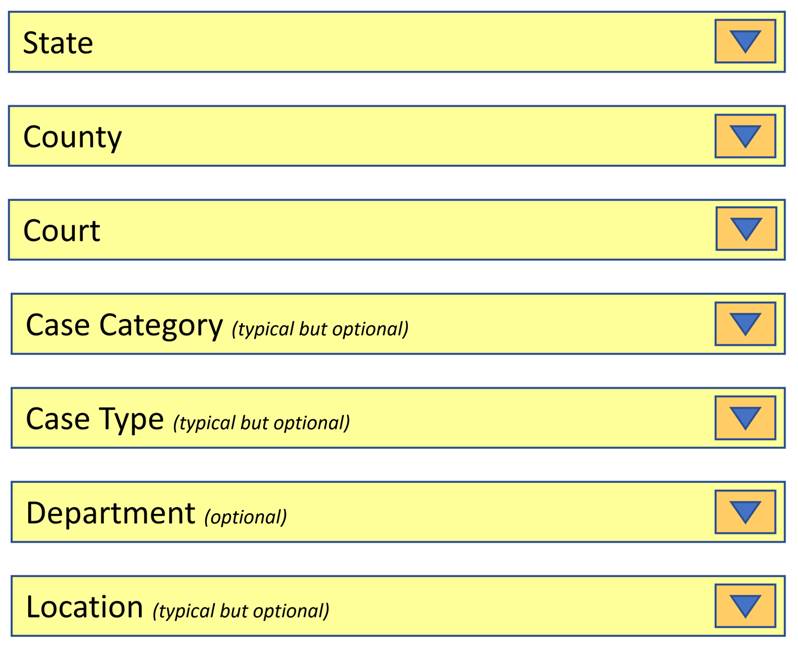Jims, All:
1. The following may be interesting:

2. Case Type can go first and Case Category second. Does not really matter.
2.1. No harm in having Subcategory or Subtype.
2.2. Useful to have a “Case Class” which generically identifies the group (see California / Georgia examples below). Could have a Case Subclass.
2.3. Some courts have a “Division” that could go between “Court” and “Case Category” or could be considered the same as “Case Category.”
3. Department often means one or more Judges. Often used for Scheduling. Less often or not used when Filing.
4. Typically see Location, although can envision this as less important in the future. Location can also be associated with a Zip Code.
5. The combination is usually associated with an Court ID or Court Key, unique with the Court Policy / Implementation that can be used to associate Court Policy values.
6. The combination can be used to disambiguate case numbers. Nice thing about this is that all data is “real” – there are no made up UUIDs or other technical identifiers – and you still get uniqueness. Not to say that you cannot or should
not use technical identifiers; only to say that this is a way to round those identifiers in the real world.
7. Examples (without Department):
State: California
County: Orange
Court: Superior
Case Category: Civil Limited
Case Type: Contract
Location: Central Justice Center
Case Class: Civil
State: California
County: San Diego
Court: Superior
Case Category: Probate
Case Type: Conservatorship
Location: Central
Case Class: Probate
State: California
County: San Diego
Court: Superior
Case Category: Juvenile
Case Type: Delinquency
Location: Central
Case Class: Juvenile
Notice the difference between California and Georgia. In California, Juvenile is a case category, whereas in Georgia Juvenile is its own court. While not “standard”, this is accurate to the court structure in those states.
State: Georgia
County: Appling
Court: Juvenile
Case Category: Delinquency
Case Type:
Location: Appling County Courthouse
Case Class: Juvenile
State: Georgia
County: Baldwin
Court: Superior
Case Category: Civil
Case Type: Tort – Automobile Accident
Location: Baldwin County Courthouse
Case Class: Civil
State: Texas
County: Bexar
Court: County Court at Law
Case Category: Condemnation
Case Type:
Location: Bexar Courthouse
Case Class:
Thanks,
Todd
From: legalxml-courtfiling@lists.oasis-open.org [mailto:legalxml-courtfiling@lists.oasis-open.org]
On Behalf Of Price, Jim
Sent: Monday, February 12, 2018 7:19 PM
To: 'James E Cabral' <jec@mtgmc.com>; legalxml-courtfiling@lists.oasis-open.org
Subject: [legalxml-courtfiling] RE: ECF 5: CaseGeneralCategoryText, CaseCategoryText, and CaseSubCategoryText
Jim,
I believe the CaseCategoryCode.gc will work for Arizona, but before committing to a definitive answer, I have a couple of questions that require clarification. Perhaps a gc primer is in order…
- Each of the “attributes” (or elements) associated with CaseCategoryCode (i.e., CaseType, CaseCategory, CaseSubCategory, and CaseSubType) appear to indicate they are required (Use=”required”). In reality,
not all of these “attribute values” are required. Does “Use=required” mean that “attribute” or element values that have no value to communicate must be present but empty in XML messages?
- From a Court Policy perspective, must each CaseCategoryCode “attribute” or element value be pre-defined? In other words, based on the table below, if a message contains ‘Non-IV-D’ in the element representing
CaseCategoryCode, does this mean that we would know, without having any of the other “attribute” or element values contained in the table, that CaseType is ‘FamilyLaw’, CaseCategory is ‘Domestic Relations’, CaseSubCategory is ‘Dissolution with Children’, and
CaseSubtype is ‘Non-IV-D’?
|
CaseCategoryCode |
Definition |
CaseType |
CaseCategory |
CaseSubCategory |
CaseSubtype |
|
Civil Penalty |
Civil Penalty |
Civil Penalty |
Civil Penalty |
Contract, Civil Penalty |
|
|
Non-IV-D |
Non-IV-D for both Dissolution and Paternity |
FamilyLaw |
Domestic Relations |
Dissolution with Children |
Non-IV-D |
|
Open Stated |
Probate |
Will |
Will |
Open Stated |
Non-IV-D |
|
Mental Health Adult |
Probate |
Probate |
Mental Health |
Mental Health Adult |
|
Thanks,
Jim
From: James E Cabral [mailto:jec@mtgmc.com]
Sent: Monday, February 05, 2018 9:19 AM
To: Price, Jim <JPrice@courts.az.gov>;
legalxml-courtfiling@lists.oasis-open.org
Subject: RE: ECF 5: CaseGeneralCategoryText, CaseCategoryText, and CaseSubCategoryText
Jim,
Here is my attempt to map the Rosetta stone to a version of CaseCategoryCode.gc for Arizona. Does this help?
__
Jim Cabral
502 509-4532
From:
legalxml-courtfiling@lists.oasis-open.org <legalxml-courtfiling@lists.oasis-open.org> on behalf of Price, Jim <JPrice@courts.az.gov>
Sent: Tuesday, January 30, 2018 12:28:28 PM
To: legalxml-courtfiling@lists.oasis-open.org
Subject: [legalxml-courtfiling] ECF 5: CaseGeneralCategoryText, CaseCategoryText, and CaseSubCategoryText
Jim Cabral,
Per today’s TC conference call, please find the attached “ECF TC - Arizona CRMDE Rosetta Stone” document. The Rosetta Stone is used in Arizona to correlate CaseGeneralCategoryText, CaseCategoryText, and CaseSubCategoryText values across
disparate CRMDEs (a Federated model approach). Note that the
highlighted text refers to the values used to set Court Policy for each of the identified CRMDEs. Please note that there are other CRMDEs not yet accounted for in the attached Rosetta Stone document.
Regards,
Jim Price